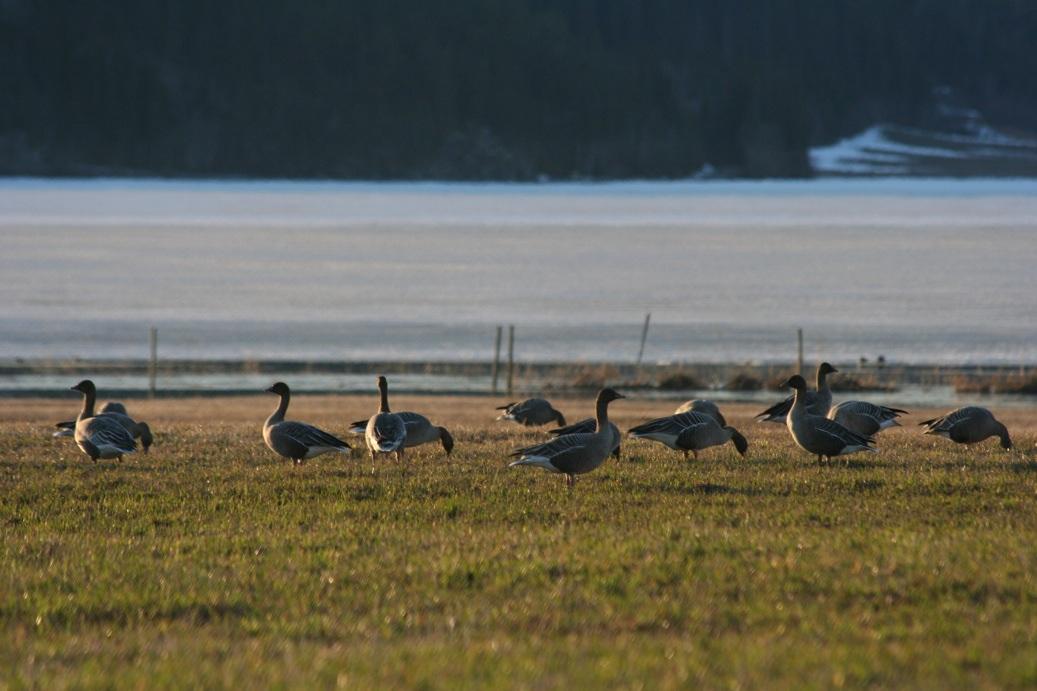To the North – habitat selection of geese during their spring migration to the high Arctic
Submitted by editor on 13 February 2015.
Understanding the distribution of species over space and time is an important aspect of ecological research and has great value for wildlife and land management. How animals choose foraging sites is typically influenced by a variety of environmental conditions including the quantity and quality of food, predation or disturbance risks, and competition from other individuals or species. To understand this process of habitat selection, many studies use predictions derived from ecological theory to explain the observed patterns. However, rarely are predictions from multiple theoretical models considered simultaneously to assess which theory, or combination thereof, best predicts observed changes in habitat selection over space and time.
Imagine pink-footed geese (Anser brachyrynchus) getting ready for their breeding season in the high Arctic. They have to accumulate enough energy to fuel further migration and to enable them to start breeding soon after their arrival to the Arctic. They have a short time to do that because the time when conditions in the Arctic are suitable for breeding and optimal time for migration is restricted. During their migration, large numbers of individual geese gather at the same stopover site. They then forage on vegetation on agricultural landscapes, which are very dynamic because farmers constantly plough and resown their fields. Because geese spend a relatively short time on each stopover site, they forage intensively. Clearly competition for food between individuals is high and at the same time geese are frequently exposed to human disturbance (perceived as predation risk). When not foraging, geese gather in large groups at the specific roost sites which are central-places on the stop-over site. Habitat depletion around such sites may therefore also shape geese foraging behaviour.

In this study we tested which ecological theories (nutrient intake maximisation, density-dependent habitat selection, central-place foraging, and predation risk effect) best-predicted geese habitat selection at their main spring migration stopover site in Mid-Norway (see figure) by computing a series of Resource Selection Functions (RSFs).
Our findings, now published in the Early View paper "Using habitat selection theories to predict the spatiotemporal distribution of migratory birds during stopover – a case study of pink-footed geese Anser brachyrhynchus" in Oikos, show that the predation risk model and a combination of the density-dependent and central-place foraging models best-predicted habitat selection as geese selected for larger fields where predation risk is typically lower and selection for foraging sites changed as a function of both distance to the roost site (i.e. central-place) and changes in local density (i.e. competition). In contrast to many other studies, the nutritional value of the available food resources was less influential in the habitat selection process as geese used the various food resources proportional to their availability.
Our study revealed that in an agricultural landscape where nutritional value of food resources is homogeneously high and resource availability changes rapidly; foraging behaviour of geese is largely a trade-off between fast refuelling and disturbance/predator avoidance. The analytical framework we adopted here can serve as a basis to try and understand habitat selection patterns of other species as most factors considered here are known to influence the behaviour of most free-ranging animals. Especially the foraging behaviour of species that regularly return to a central-place and forage in large groups in landscapes with anthropogenic disturbances may be influenced by a combination of environmental factors in a similar manner to those observed for pink-footed geese in our study. Overall, one single framework may be insufficient to explain the observed variation in foraging behaviour of animals as multiple conditions are expected to influence habitat selection patterns.
The authors through Magda E. Chudzińska